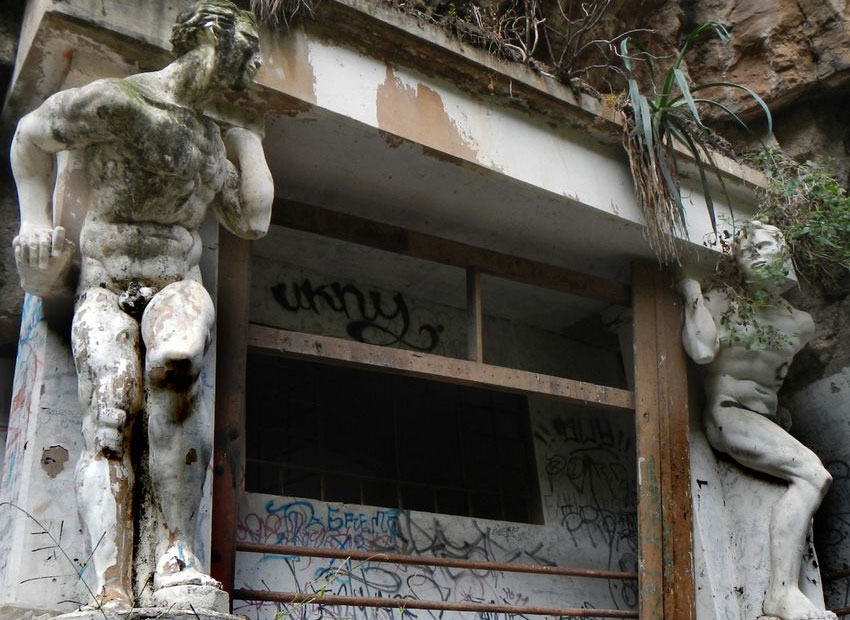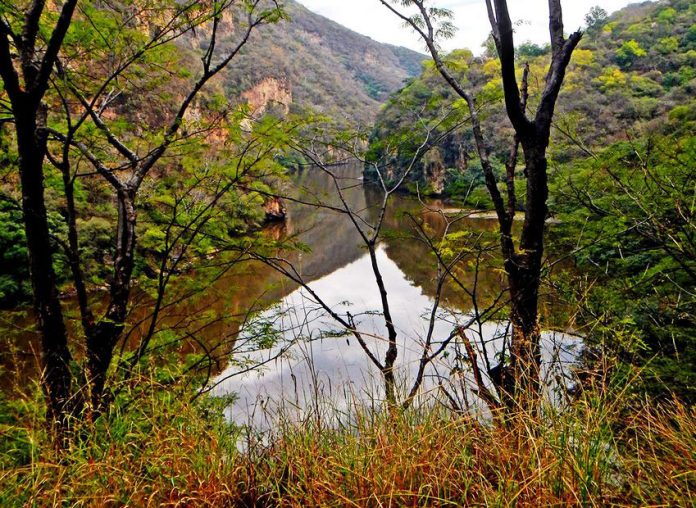Years ago I was told tales about “two stone giants” standing guard over ruins deep inside one of the barrancas of the ubiquitous Santiago River, which wraps itself around the city of Guadalajara.
The exact location of those monos, as they are popularly called, escaped me until I mentioned them to my friend Rodrigo Orozco. “Los Atlantes de Colimilla? I know exactly where they are … let’s go!”
The next day we drove to the northeast corner of the city, where we found a rather shabby-looking barrio romantically but deceptively named Jardines Del Prado (Meadow Gardens). Here a winding cobblestone road led us down to a checkpoint manned by armed guards.
“Proceed no further,” they told us, “unless you have written permission from the state water commission.” This we did not have but, fortunately, we did have a friend who knew a friend who knew a friend and thanks to all that friendliness they actually let us through the gate, allowing us to continue along “El Camino a La Planta Potabilizadora Colimilla.”
No sooner had we passed the guards than we caught a glimpse of the river below us with a towering canyon wall on the other side. Although the Santiago is horribly polluted at many points here, at this particular spot, we could discern no bad smell and to tell you the truth, we were astounded at the beauty of the scene. It was dead quiet.

White and gray egrets were frolicking in the river which was full of fish — yes, live fish! — and on a branch above the water a kingfisher was preparing to dive. On the canyon wall behind us, a lacy waterfall was trickling. It was hard to believe we were only 13 kilometers from the city’s bustling Ring Road.
As we followed the river downstream toward the dam, we stopped again and again, jumping out of the car, even though it was drizzling, to take yet another photo. “This canyon,” I told my friend, “could be turned into a gorgeous park with little cafés overlooking the river. In my opinion, it would surpass the San Antonio Riverwalk by 10 magnitudes … just look at that incredible canyon wall towering above us!”
“Yes,” said Rodrigo, “but instead we Tapatíos dump our excrement and toxic waste into it — ¡qué lástima!”
We soon reached the huge, impressive cortina or dam and just beyond it the ruins of what was once the main hydroelectric plant supplying electricity to Guadalajara. It was built between 1945 and 1950 and once upon a time supplied 51 megawatts of power. Today, however, it is utterly abandoned and has been replaced by another plant farther down the river.
Wandering around the ruins of this once impressive operation, we started looking for the “5,000 stairs” that rumor says lead down, down, down to the river. Well, the actual number of steps turned out to be 200, which I know because my grandnieces Xela and Meli counted them.
But it was well worth the effort. At the bottom you come to the dam’s spillway, which handled its overflow. The water pours out beneath an arch which in turn is flanked by huge statues of two young men wearing nothing but hairstyles right out of the 1950s. Each is about three meters tall and they reminded me of statues I saw in Italy commissioned by Mussolini in a futile attempt to bring back the grandeur of ancient Rome.

These in Guadalajara are known as the Atlantes de Colimilla and they are truly the last thing you’d expect to find at the bottom of a deep canyon 300 meters below the streets of a big metropolis. Sad to say, both statues were covered by grime and graffiti, accumulated over the decades.
At a distance of 7.3 kilometers from the checkpoint, we were delighted and surprised to find several rustic hot pools. We should not have been surprised, actually, because — as a geologist later informed me — that particular bend of the river is located inside the remains of Colimilla Volcano which was eroded away two million years ago by the Santiago River. At that time, it seems, much of Jalisco was a big lake and when water began to drain from it, colossal canyons were slowly formed, those same canyons which we can appreciate today all along the northern edge of the city of Guadalajara.
I put on my swim suit, anxious to take a dip in the hot water, which I had assumed would be coming from a hot spring. However, to my surprise I learned there is a full-fledged river here, which tumbles down hundreds of meters from somewhere high up the steep canyon side.
Local people have made all sorts of clever little outdoor dams here, but up above, so I was told, are Las Pilitas de Tonalá, long, lovely hot pools — some of them 40 degrees hot — hanging in space like giant balconies and offering bathers what is said to be an awesome view of the barranca.
As for the pools at the riverside, I found the water temperature delightful. On top of that, there were only a couple of dozen people present, even though it was a Saturday. Naturally, I wondered how they had reached this point because ours was the only car to be seen anywhere around and the road we were on was supposed to be closed to the public.
“Oh, there’s a path that leads down here from the barrio up above,” we were told. Ah yes, I was so enamored with the beauty and solitude of this place that I had actually forgotten that it’s located smack on the edge of a city teeming with five million people.
[soliloquy id="120008"]
Upon my return home, I tried to find out who had sculpted those two Colimilla Atlanteans. From José Guadalupe Gutiérrez of the Historical Society of Tonalá I learned that the two big statues were sculpted between 1945 and 1950 by one Ramiro Gaviño and are considered good examples of Art Deco.
After much digging on the internet, I learned that Ramiro Sergio Gaviño Rivera was an architect and sculptor from Mexico City, creator of El Monumento al Caminero, a set of three very big and very impressive statues in the capital’s La Joya colony, honoring the Road Builder and inaugurated in 1956.
From Erick González Rizo, president of Xalixco Estudios Históricos, I further learned that the Atlantes de Colimilla are no longer covered in grime and graffiti. “People in the neighborhood, living up above the river,” González told me, “decided on their own initiative that it was high time to clean up those statues, of which they are quite proud.
“Led by one Ruby Galindo, dozens of local people descended upon the site carrying cleaning implements, collapsible ladders and buckets of paint and in a few weeks restored the old spillway to its former glory.”
Let me also add that those volunteers accomplished all this without benefit of motor vehicles, walking up and down that steep hill I don’t know how many times. Bravo, Ruby and friends! Once again private initiative comes to the rescue when politicians fail to do their job.
Oh by the way, did I forget to mention that Colimilla Canyon is a so-called “protected area?”
The writer has lived near Guadalajara, Jalisco, for more than 30 years and is the author of A Guide to West Mexico’s Guachimontones and Surrounding Area and co-author of Outdoors in Western Mexico. More of his writing can be found on his website.
